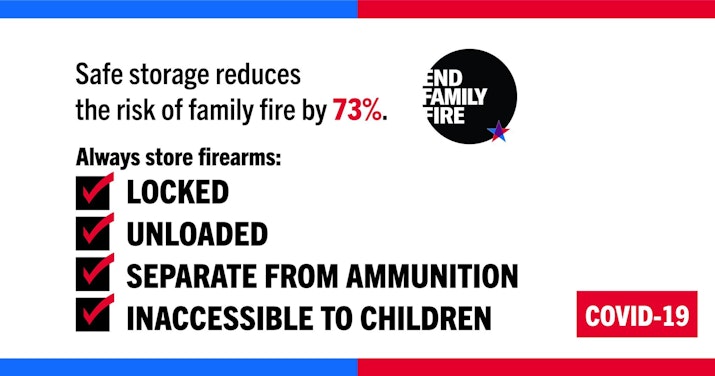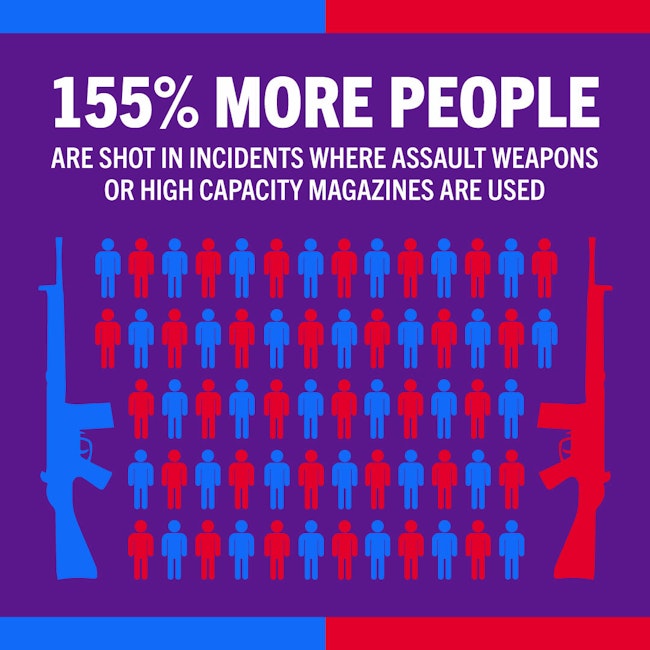Gun Ownership
Today there are more guns than people in the United States, and with gun ownership comes responsibility.
Brady acknowledges the important role that responsible gun owners play in our communities. Gun owners are an essential part of preventing gun violence.
In the U.S., one in three adults personally own a gun, and 66% of gun owners own more than one gun. Whether you’re a new gun owner or your family has been hunting or target shooting for generations, there are steps we can all take to continue to enjoy guns while also working to prevent gun violence. Take these important steps before, during, and after the purchase of a firearm to both protect your family and help keep guns from being misused.

When considering to buy a gun:
- Talk to gun owners you know about their safe storage practices, responsible gun usage, and local laws pertaining to gun storage, possession, and use.
- Obtain sufficient training and knowledge of the firearm(s) you intend to purchase before bringing one into your home.
- Research the various gun storage options available to determine which is best suited for your household. Learn about how you can reduce the risk of family fire – which refers to a shooting caused by someone having access to a gun from the home when they shouldn’t have it. This includes children as well as those who display behavior that indicates they could harm themselves or others.
- Have conversations with family members about what it would mean for you to bring a gun into your shared living space. Take into consideration family circumstances and individual risk factors, such as the presence of children or older adults in the home. If your family is not confident or has doubts about gun ownership, consider other options. Home security systems, alarms, and guard dogs are possible alternatives.
- Each state has different laws regulating firearms. Learn about the gun laws in your state to ensure you are in compliance. Information can typically be found on your state’s government website.
While buying a gun:
Ask your gun dealer about safe firearm storage options for your home. From gun locks to safes, there are a wide variety of effective ways to store your guns safely that can be tailored to your specific household and family circumstances.
- Trigger locks and cable locks prevent a firearm from being fired until the device is unlocked and removed from the firearm.
- Trigger locks: External locks that are attached directly to the firearm.
- Cable locks: Threaded through the chamber of the firearm, keeping the chamber open and empty.
- Lockboxes, carrying cases, and safes can help protect firearms from damage.
- Lockboxes and gun carrying cases should include one of the following: an external lock paired with physical keys, an electronic combination lock, or a fingerprint-recognition lock.
- Gun safes: Ranging in size, they allow you to safely store more than one firearm at a time. Some safes offer biometric technology, which only recognizes and opens with your unique fingerprint. Biometric technology also allows for quick access.
Ask your gun dealer relevant questions about using the correct ammunition, proper ear and eye protection for shooting sports, as well as how to maintain the proper functioning of your firearm.
After buying a gun:
Learn about programs and policies in your community that help reduce the risk of family fire:
- We recognize that many gun owners, especially those of Black, Latinx, and Native American descent, may be wary of interacting with police for any reason, much less in regards to firearms. That being said, for those who are comfortable local police departments provide resources about community programs that teach the fundamentals of firearm safety or distribute firearm locks and information about safe gun storage. They may also provide resources about offsite storage. Contact your local police department to see if there is gun safety counseling or a gun lock distribution program in your area.
- Familiarize yourself with the available mechanisms to help someone who may be in a temporary crisis, like Extreme Risk Protection Orders.
- Open up conversations with your friends, family, and community about responsible gun ownership, and learn more about Brady’s programs, where we invite gun owners and non-gun owners to be part of the conversation – and the solution – to gun violence in our communities.
- Always secure the firearms in your home to protect loved ones from the risks of family fire. As your home situation changes, reevaluate how your storage practices may need to change as well.
- If traveling, transport your gun locked inside a cool, clean, dry carrying case or storage box.
- When transporting a firearm, take the same precautions you do while in your home. Unintentional shootings can happen anywhere — so it is important to ensure your gun is stored in a locked container, ideally secured to the frame of your car. Research the various cases and safes specifically designed for your car to find the best option for you.
- Storing guns in glove boxes or trunks without any additional precautions is not recommended, as both can easily be broken into.
- If you happen to let another person drive your car, ensure that they know you keep your firearms inside or consider removing the firearms altogether before you give another person access to your vehicle.
- For information on how to travel safely with firearms at airports, The Transportation Security Administration has specific guidelines for transporting firearms and ammunition through airports and on commercial aircraft.
For more information about what a responsible gun dealer should look like, read our Brady Gun Dealer Code of Conduct.
WHEN USING A Gun:
Act responsibly and always practice the following firearm safety tips:
- Treat every gun as if it is loaded. Always treat your gun as if it could fire at any time. Even when cleaning or transporting your gun, accidents can — and do — happen. Many people have been unintentionally injured or killed because they assumed their gun was unloaded — treating every gun as if it is loaded will help prevent those injuries.
- Know your target and what lies beyond it. Only point your gun at something you intend to shoot, and maintain control over the muzzle of your gun at all times.
Ensure complete awareness for not just your target but what surrounds it as well. When using your gun, it is critical that you only point your gun at its intended target. - Keep your finger off the trigger until you intend to fire. Only put your finger on the trigger when you have identified your target and are ready to fire.
- Keep your gun’s “safety” on until you intend to fire, but do not solely rely on your gun’s “safety” feature. The “safety” on a gun is a feature that should serve as a supplement to proper gun handling, but it is not a replacement for responsible firearm use. Like any mechanical device, a safety feature could easily become inoperable.
- Use the correct ammunition. There are many kinds of firearms and ammunition available, making it critical to match your ammunition with the right rifle, shotgun, or handgun. To ensure that you are using the proper caliber or gauge for your specific firearm, review the gun’s instruction manual as well as the manufacturer’s markings on the gun itself. Be sure to read the information on the lid of the box of ammunition. Using the wrong ammunition will damage your firearm and potentially cause serious injury, as the barrel of the gun can explode.
- Firearms should be unloaded when not in use. We know that kids are curious and they can get into everything. To protect our kids and ensure that our homes are safe, act responsibly and ensure all guns are unloaded when they are not in use.
- Only use a firearm when you are in full control of your body: Never consume alcohol before or while you handle a firearm. You wouldn't let your friend drive drunk, so why would you let them use their gun after drinking? Guns, like cars, have the capacity to do great harm and require full awareness to operate properly. As an issue of public safety, we must do our part to ensure that we are keeping our communities safe — don’t drink and carry.
- Engaging in shooting sports? Use the proper ear and eye protection. The best way to protect from any eye or ear injuries at the shooting range or in the field is to use the proper safety gear. It’s easy to purchase, relatively inexpensive, and will help protect our families.
- Maintain high machine function for your firearm: Don’t alter or modify your gun and ensure it is regularly serviced. Clean your guns after each use and make sure that the barrel of your gun is clear of any obstructions before shooting. Keep your firearms in high-working order to ensure proper usage.
- If your gun is not firing when the trigger is pulled, handle with care and don’t attempt to fire again.
If there comes a time in your life when you decide you no longer want a gun that's in your possession, please make sure to check the local laws and regulations regarding removing that gun from your possession. As different states have different laws, your local police department may have the most accurate information.






